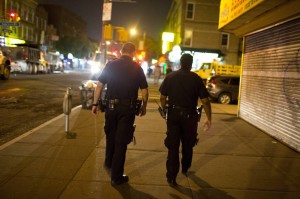By Edward Conlon,
from The Wall Street Journal,
9/4/15:
Police bias and misconduct are serious problems—but so is the epidemic of homicide among young black men.

Since last August, when a cop shot and killed Michael Brown in Ferguson, Mo., accounts of the deaths of African-American men at the hands of police have dominated the news. The names of the dead—Brown, Garner, Crawford, Rice, Harris, Scott, Gray—have an Everyman quality about them. The cases have provoked outrage. Rep. Hank Johnson, an African-American member of Congress from Georgia, took to the floor of the House to say that “It feels like open season on black men in America.”
Others have compared the incidents to an epidemic, even to genocide. Iran’s Ayatollah Khamenei has tweeted about Ferguson. Michael Brown’s parents were flown to Switzerland to address the U.N. Committee Against Torture, and many see the activism that has emerged since Brown’s death as the onset of a great moral awakening.
It’s not up to me to decide what activists should protest, but after years of dealing with the realities of street violence, I don’t understand how a movement called “Black Lives Matter” can ignore the leading cause of death among young black men in the U.S., which is homicide by their peers.
In 2011, the Centers for Disease Control and Prevention counted 129 instances of black men killed by “legal intervention”—that is to say, by cops. The figure is incomplete because of a lack of national reporting requirements, and it says nothing about the circumstances of the killings or the race of the officers involved. But it gives a sense of the scope of the problem.
By contrast, in that same year, 6,739 black men were murdered, overwhelmingly by young men like themselves. Since 2001, even as rates of violent crime have dropped dramatically, more than 90,000 black men in the U.S. have been killed by other black men. With fatalities on this scale, the term epidemic is not a metaphor. Every year, the casualty count of black-on-black crime is twice that of the death toll of 9/11.
To talk about this vast slaughter isn’t changing the subject from police misconduct. It’s the only way a conversation about reforming police practices can begin.
In March, Attorney General Eric Holder released two reports on Ferguson. One covered in great detail the shooting death of Michael Brown by Officer Darren Wilson; the other described the broader patterns of policing in the city. Partisans have tended to choose one report or the other to support their reading of events.
No, Brown wasn’t shot in the back while attempting to surrender to a white cop, nor was he shot for jaywalking. He had just robbed a store, and he had punched Officer Wilson in the face and tried to steal his gun. In the wake of Brown’s death, Ferguson burned because people believed a lie; because many still believe it, cops have been shot there, and the threat of riot remains.
The other report showed that Ferguson was a speed trap for people going nowhere, six square miles of mostly black people, mostly poor, with 50 cops, almost all white, who were ordered to milk them for every possible nickel by white city managers. Black people were further bled dry in a punitive cycle of fines and fees; missed court dates led to arrest warrants, which left them increasingly incapable of having a chance at a productive life.
Which story to emphasize? It depends on your agenda. The more egregious practices of the Ferguson police have been curbed, and thousands of warrants have been vacated. Still, by most reports, the mood there remains tense, and homes have lost half their value.
For most cops and their supporters, the rising homicide rate over the past year—surging in Baltimore and St. Louis, creeping up in New York and elsewhere—is the inevitable result of demoralized police departments. The price of rage can be calculated in the number of cops who have been targeted and shot—most notoriously, NYPD officers Wenjian Liu and Rafael Ramos last December and, just last week, Deputy Darren Goforth in Texas.
No cop I worked with would disagree with the protester’s chant that black lives matter. I spent a substantial part of my career begging black kids to tell me who shot them. Often, they wouldn’t. When they were killed, there was no guarantee that their friends and family would tell me what had happened, let alone agree to testify in court. And the enormous effort undertaken to get as far as an arrest—knocking on countless doors, calming and cajoling fearful witnesses—was often labor in vain.
Simply put, the Bronx is an excellent place to kill someone. While your odds of getting caught are slightly better than even, the chances of beating the rap are in your favor. The conviction rate for felonies in the Bronx is the lowest in the city, by far.
For Bronx cops, tales of travesty take up quite a bit of shelf space in their library of job stories. I had a cab robbery in which the two perpetrators were caught in the act by a camera attached to the rearview mirror of the car. The photo that ran in the Daily News was so flattering that one of them had the clipping in his pocket when I arrested him. The case didn’t make it out of the grand jury.
Another time, I had what seemed to be a straightforward attempted murder—a car full of bullet holes, two blameless, hardworking black victims, a recorded threat by a perpetrator with a long record of violent crimes. He apparently believed that one of the men had been seeing his ex-girlfriend. When I went to arrest him, he grabbed a baby and held it up, yelling, “Shoot me! Shoot me!” He was acquitted, for reasons that still escape me.
When I hear about the “nonviolent drug offenders” doing time, I can’t help wondering how many of them have a shooting or three they got a pass on. There may be a growing consensus that too many men are in prison in America today, but I know that not enough from the Bronx are there. The system is broken in more ways than one.
So what happened? As a DA friend once told me, these incomprehensible acquittals were often surreptitious acts of hope. Maybe some of those nice church ladies who always said hello to me when I was a beat cop were on the jury. Any prosecutor would have gladly picked them. In my first tour of the projects, I saw the church ladies and the corner boys—the ones doing stickups and hustling crack—as two distinct groups. But they weren’t, really, because the lovely old grannies had sons and nephews and grandsons, and the corner took its share of them. They didn’t have to disbelieve a white detective; they only had to see the defendant, and think about their family, and pray that God will be good.
We should read both reports about Ferguson, not just the one that validates what we already believe, and the CDC data, so that we don’t forget the dead black kids who don’t make the news.
What we can’t do is pretend that police will solve the problem. The boys and girls on the corner have to find somewhere better to go, and few believe that most of them will get there anytime soon. We can only hope that the experts are wrong, as they’ve so often been before. Maybe the church lady on the jury is right, and redemption is never out of reach.
More From The Wall Street Journal (subscription required):















